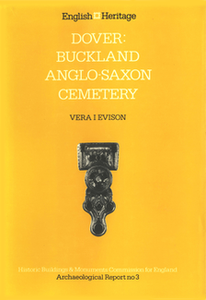English Heritage Archaeological Monographs
English Heritage, 2014. https://doi.org/10.5284/1028203. How to cite using this DOI
Data copyright © English Heritage unless otherwise stated
This work is licensed under the ADS Terms of Use and Access.
Primary contact
Historic England
The Engine House
Firefly Avenue
Swindon
SN2 2EH
Resource identifiers
- ADS Collection: 1416
- DOI:https://doi.org/10.5284/1028203
- How to cite using this DOI
Dover: Buckland Anglo-Saxon Cemetery
Evison, V.
English Heritage (1987)
Abstract:

The Anglo-Saxon cemetery at Buckland, Dover, was discovered when a new housing estate was being constructed in 1951. It was excavated by Professor Evison between 1951 and 1953. The cemetery of some 170 graves dates from the late fifth to the middle of the eighth century. Professor Evison's expertise in the study of glass, jewellery and weapons ensures that there is a penetrating analysis of this important site and interesting ideas are proposed for the layout and phasing of the cemetery. A comprehensive discussion of the finds from the graves reveals that, although the Buckland cemetery belongs to the period of pagan tradition of burial with grave goods, there is some evidence of Christian influences and rites. Contact with Frankish territory in France, Belgium and the Rhineland seems to have been maintained throughout the period of use of the cemetery and Frankish grave goods formed an important element in the material culture of the people buried there. However, by the late sixth century local Kentish craftsmen were producing a significant amount of the jewellery found in the graves. Professor Evison places the Buckland cemetery in its local context by examining contemporary finds from other sites in the area around Dover.
Download monograph
| Dover: Buckland Anglo-Saxon Cemetery, Evison, V., English Heritage (1987), ISBN: 9781848021433 | 62 Mb |





